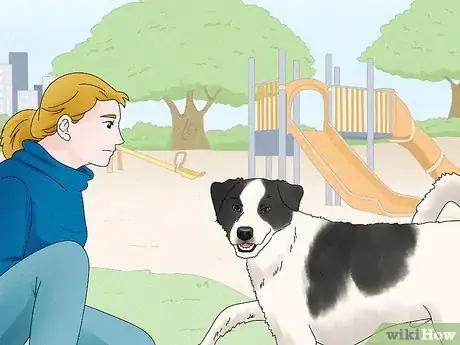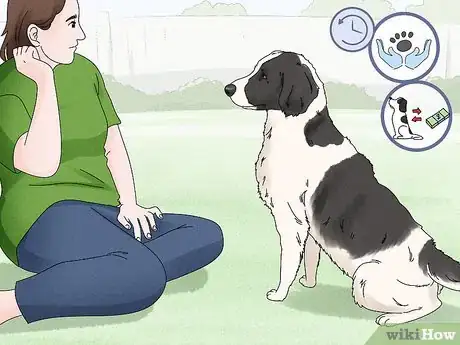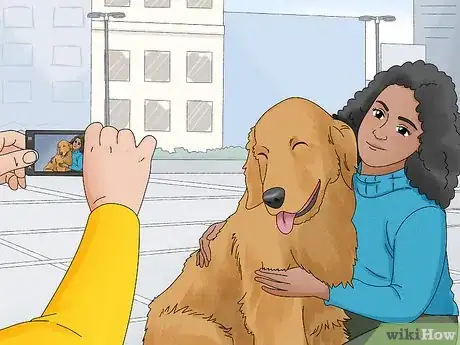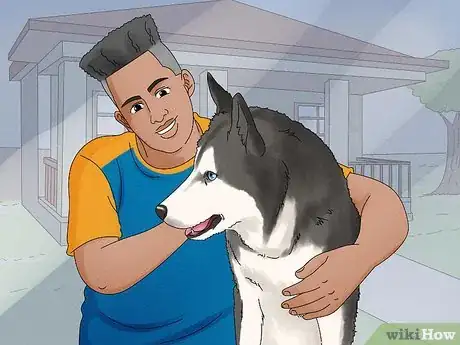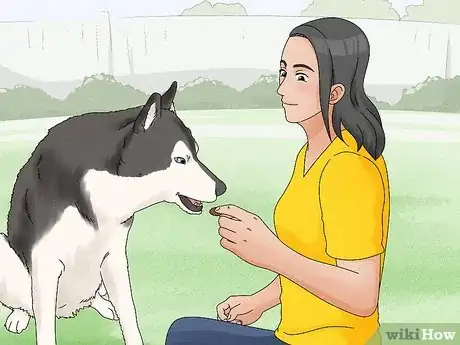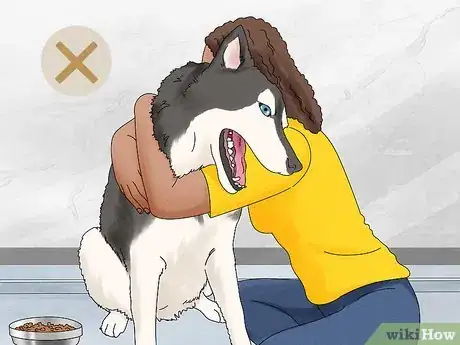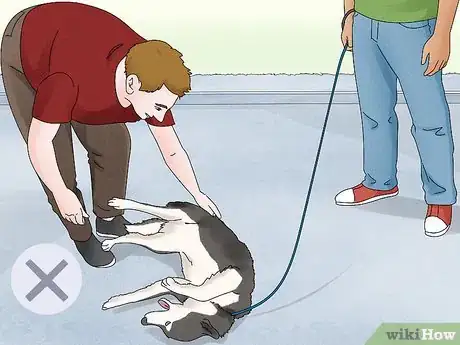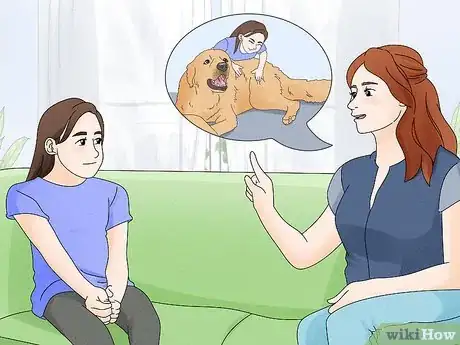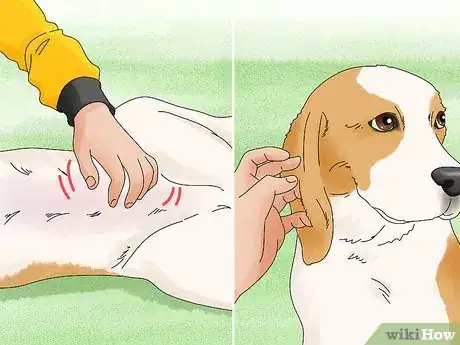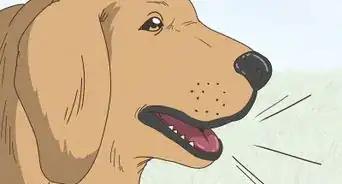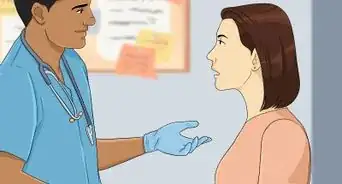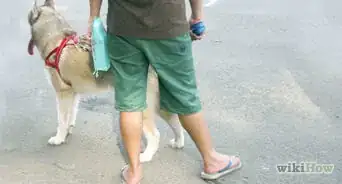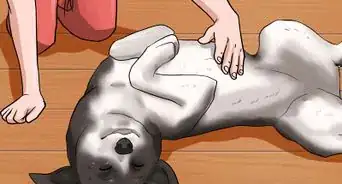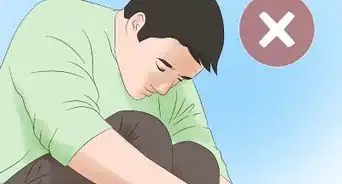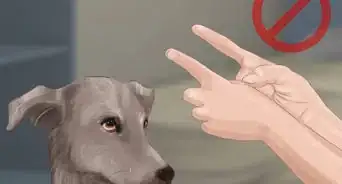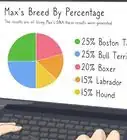This article was co-authored by Jennifer Damon. Jennifer Damon is a Professional Dog Trainer and the Owner of Love for Paws Dog Training in Richmond, VA. With over 10 years of experience training dogs, Jennifer specializes in determining the psychology that motivates dog behavior. As a supporting member of the International Association of Animal Behavior Consultants, Jennifer is passionate about improving the communication between owners and their pets through gentle, scientifically-backed methods. She holds a BFA in Communication Arts from the University of Montevallo and a Certificate in Canine Behavior Consulting from The International College of Canine Studies.
There are 7 references cited in this article, which can be found at the bottom of the page.
This article has been viewed 76,160 times.
Humans are hardwired to understand hugs as expressions of affection, so it can be difficult to believe that this bodily gesture might not be universally perceived as positive and enjoyable. This is precisely the case, though, when it comes to your pet pooch. Unlike humans, they can react to hugs with discomfort, fear, nervousness, and even aggression, so you should make sure your dog is happy with your hugs before you wrap your arms around them.[1] Simply pay attention to their behavioral signs, help them adjust gradually, and learn other, canine-customized ways to express your love.
Steps
Evaluating Your Dog’s Behavior
-
1Identify signs of anxiety and stress. While dogs express high levels of anxiety and fear through generally recognized behaviors, such as growling or teeth-baring, they show milder feelings of discomfort in subtler ways. In order to figure out if your dog likes hugs, you should learn to recognize these less overt signals: after all, just because your dog tolerates your hugs, doesn’t mean they enjoy it.[2] [3]
- For example, check to see if your dog turns its head away from yours, closes its eyes or shows the whites of them, lowers its ears, licks its lips, or closes its mouth. Yawning, soft whining, and paw lifting can also be signs of stress.[4]
- Additionally, take note of your dog’s behavior after you embrace it. If it shakes its coat as if it’s just had a bath, it’s showing that it didn’t particularly enjoy the hug.[5]
-
2Consider your dog’s background. Just like humans, dogs receive and respond to bodily contact due largely to their background and experience. If they have abuse in their past, for instance, they’re unlikely to be comfortable with close physical contact. Or, if they’ve been well-treated by previous owners but are older in age and unaccustomed to hugs, they’re probably going to prefer you keep your hugs to fellow humans.[6]
- Similarly, consider your own personal history and relationship with the dog. If you’ve only recently adopted or purchased the dog, you should wait until the two of you become better acquainted before you try hugging it.
Advertisement -
3Have someone photograph you while hugging your dog. If you’re still unsure as to whether or not your dog really enjoys your affectionate overtures, ask a friend or family member to take a snapshot while you’re mid-embrace. You’ll be able to assess the expression on your dog’s face in a way that you can’t when you’ve got your arms wrapped around it.[7]
- Some experts also recommend watching your dog get hugs from another close family member or friend. As they lean into a hug and lean back out again several times, you’ll see if your dog displays any anxious behaviors in consistent and explicit connection with hugs.
Helping Your Dog Become Accustomed to Hugs
-
1Familiarize your dog with half-hugs and general closeness. Many experts recommend foregoing canine hugs entirely, but if you just must embrace your pup, you should work up to it slowly.[8] When your dog is sitting still and relaxing, sit next to it with your shoulders touching. Slowly rest your hand and then arm on top of its back, give it a treat, and start encircling your arm more and more around your dog’s shoulders and neck.[9]
-
2Use treats to link hugs with positive associations. Once you've worked up to a hug with gradual closeness and intermediary levels of contact, you can begin hugging your dog. Just be sure to do so with positive reinforcement: give your dog a brief hug, then reward it with a treat. Repeat often over time and make the hugs longer the more tolerant your dog becomes.[10]
- Many widely available dog treats are the equivalent of human junk food, so look for small, organic varieties, or use tiny bits of chicken or turkey.
-
3Evaluate the appropriateness of the situation. Even if you’re pretty sure your dog loves hugs, remember that some moments are more opportune than others when it comes to cuddles. For example, never go in for a snuggle when your dog is eating or playing vigorously with another dog.[11]
- For the best reception, embrace your dog when you’re both at home alone together and the dog feels relaxed, secure, and happy.
-
4Never hug a strange dog. No matter how adorable that dog at the park is or how jubilantly they might have approached you, you should never assume that a strange dog will be amenable to your hug. After all, even the friendliest dogs don’t greet other dogs with hugs; they show their interest in one another through tail wagging, sniffing, and licking.[12]
- In the same way, you should refuse when others ask to hug your dog. Even if your dog has never bitten or growled at anyone, you never know how they’ll react to a new person’s smell and movements.
-
5Discourage children from hugging your dog. Children are not good at discerning distress in dogs, even explicit threat signals such as snarling and bristling. Gently and firmly discourage children from giving your dog hugs.[13]
- If your child persists in wanting to hug your dog, try educating them on other ways they can show their love. Teach them to tickle the dog’s tummy, rub its ears, and stroke its back.
Showing Affection in Other Ways
-
1Understand what hugging behavior means for dogs. In order to understand why hugging is probably not the best way to exhibit love to your dog, think about what hugs mean in the dog world. When dogs greet, play, or cuddle with one another, they do all sorts of things, but they almost certainly don’t hug in the way that humans do.[14]
- Even if your dog doesn’t perceive your hugs in the way that it would from another dog, they could be uncomfortable with it for other reasons. Some experts point out that dogs rely on speed and flight as their escape from danger, so a hug—which naturally arrests or immobilizes them—can seem like a threat or at least a source of anxiety.[15]
-
2Know that your dog’s distaste for hugs doesn’t indicate a lack of love. You might object to the idea that your dog doesn’t actually like hugs because you think it means they don’t love you. Remember, though, that hugs simply don’t mean the same thing to dogs that they do to humans, so their distaste for hugs has nothing to do with their feelings for you as a companion, friend, and family member.[16]
-
3Give your dog easily understood gestures, such as belly-rubs or ear scratches. As you probably already know, dogs are very affectionate animals. They love to receive and give love through physical contact, just not necessarily in the same way that humans do.[17] Instead of hugging, give your dog a belly rub, scratch their ears, or massage their shoulders and back.[18]
- If you let your dog sleep on the bed, let them snuggle up at bedtime! Many dogs will be comfortable with close, sustained contact during sleep that they wouldn’t tolerate in other situations.
Expert Q&A
-
QuestionIs it OK to hug and kiss your dog?
 Jennifer DamonJennifer Damon is a Professional Dog Trainer and the Owner of Love for Paws Dog Training in Richmond, VA. With over 10 years of experience training dogs, Jennifer specializes in determining the psychology that motivates dog behavior. As a supporting member of the International Association of Animal Behavior Consultants, Jennifer is passionate about improving the communication between owners and their pets through gentle, scientifically-backed methods. She holds a BFA in Communication Arts from the University of Montevallo and a Certificate in Canine Behavior Consulting from The International College of Canine Studies.
Jennifer DamonJennifer Damon is a Professional Dog Trainer and the Owner of Love for Paws Dog Training in Richmond, VA. With over 10 years of experience training dogs, Jennifer specializes in determining the psychology that motivates dog behavior. As a supporting member of the International Association of Animal Behavior Consultants, Jennifer is passionate about improving the communication between owners and their pets through gentle, scientifically-backed methods. She holds a BFA in Communication Arts from the University of Montevallo and a Certificate in Canine Behavior Consulting from The International College of Canine Studies.
Professional Dog Trainer It depends on what your dog enjoys and responds to. I think we tend to assume that if a person enjoys something it will also be enjoyable for dogs, but that simply isn't the case. Some dogs may not appreciate or feel comfortable with your hugs and kisses, while other dogs may love them.
It depends on what your dog enjoys and responds to. I think we tend to assume that if a person enjoys something it will also be enjoyable for dogs, but that simply isn't the case. Some dogs may not appreciate or feel comfortable with your hugs and kisses, while other dogs may love them. -
QuestionWhat does a hug mean to a dog?
 Jennifer DamonJennifer Damon is a Professional Dog Trainer and the Owner of Love for Paws Dog Training in Richmond, VA. With over 10 years of experience training dogs, Jennifer specializes in determining the psychology that motivates dog behavior. As a supporting member of the International Association of Animal Behavior Consultants, Jennifer is passionate about improving the communication between owners and their pets through gentle, scientifically-backed methods. She holds a BFA in Communication Arts from the University of Montevallo and a Certificate in Canine Behavior Consulting from The International College of Canine Studies.
Jennifer DamonJennifer Damon is a Professional Dog Trainer and the Owner of Love for Paws Dog Training in Richmond, VA. With over 10 years of experience training dogs, Jennifer specializes in determining the psychology that motivates dog behavior. As a supporting member of the International Association of Animal Behavior Consultants, Jennifer is passionate about improving the communication between owners and their pets through gentle, scientifically-backed methods. She holds a BFA in Communication Arts from the University of Montevallo and a Certificate in Canine Behavior Consulting from The International College of Canine Studies.
Professional Dog Trainer They could interpret it as a sign of affection or closeness, but they may also feel like you're restricting them or trying to keep them still, which may make them uncomfortable. Just pay attention to their body language to see how your dog responds.
They could interpret it as a sign of affection or closeness, but they may also feel like you're restricting them or trying to keep them still, which may make them uncomfortable. Just pay attention to their body language to see how your dog responds. -
QuestionCan I just try hugging my dog?
 Jennifer DamonJennifer Damon is a Professional Dog Trainer and the Owner of Love for Paws Dog Training in Richmond, VA. With over 10 years of experience training dogs, Jennifer specializes in determining the psychology that motivates dog behavior. As a supporting member of the International Association of Animal Behavior Consultants, Jennifer is passionate about improving the communication between owners and their pets through gentle, scientifically-backed methods. She holds a BFA in Communication Arts from the University of Montevallo and a Certificate in Canine Behavior Consulting from The International College of Canine Studies.
Jennifer DamonJennifer Damon is a Professional Dog Trainer and the Owner of Love for Paws Dog Training in Richmond, VA. With over 10 years of experience training dogs, Jennifer specializes in determining the psychology that motivates dog behavior. As a supporting member of the International Association of Animal Behavior Consultants, Jennifer is passionate about improving the communication between owners and their pets through gentle, scientifically-backed methods. She holds a BFA in Communication Arts from the University of Montevallo and a Certificate in Canine Behavior Consulting from The International College of Canine Studies.
Professional Dog Trainer I'd recommend going slowly here. Try just sitting next to them, touching them slowly, and waiting to see how they respond. You can give them treats to try and get them to respond more positively to you. If you just suddenly hug them, they may not enjoy it and they might bite you if so inclined.
I'd recommend going slowly here. Try just sitting next to them, touching them slowly, and waiting to see how they respond. You can give them treats to try and get them to respond more positively to you. If you just suddenly hug them, they may not enjoy it and they might bite you if so inclined.
References
- ↑ https://www.psychologytoday.com/blog/canine-corner/201604/the-data-says-dont-hug-the-dog
- ↑ https://www.psychologytoday.com/blog/canine-corner/201604/the-data-says-dont-hug-the-dog
- ↑ Jennifer Damon. Professional Dog Trainer. Expert Interview. 1 March 2021.
- ↑ https://www.psychologytoday.com/blog/canine-corner/201604/the-data-says-dont-hug-the-dog
- ↑ https://www.nytimes.com/2016/04/28/science/can-you-hug-your-dog-yes-but.html
- ↑ https://www.nytimes.com/2016/04/28/science/can-you-hug-your-dog-yes-but.html
- ↑ http://www.mnn.com/family/pets/stories/why-dogs-dont-like-to-be-hugged
- ↑ Jennifer Damon. Professional Dog Trainer. Expert Interview. 1 March 2021.
- ↑ http://www.mnn.com/family/pets/stories/why-dogs-dont-like-to-be-hugged
- ↑ https://www.nytimes.com/2016/04/28/science/can-you-hug-your-dog-yes-but.html
- ↑ http://www.npr.org/2016/04/30/476212898/lets-not-hug-it-out-with-our-dogs
- ↑ http://www.npr.org/2016/04/30/476212898/lets-not-hug-it-out-with-our-dogs
- ↑ https://www.psychologytoday.com/blog/canine-corner/201102/why-children-suffer-the-greatest-risk-dog-bites
- ↑ http://www.mnn.com/family/pets/stories/why-dogs-dont-like-to-be-hugged
- ↑ https://www.psychologytoday.com/blog/canine-corner/201604/the-data-says-dont-hug-the-dog
- ↑ http://www.mnn.com/family/pets/stories/why-dogs-dont-like-to-be-hugged
- ↑ Jennifer Damon. Professional Dog Trainer. Expert Interview. 1 March 2021.
- ↑ https://www.washingtonpost.com/news/speaking-of-science/wp/2016/04/27/no-science-didnt-prove-that-dogs-hate-hugs/?utm_term=.11db5876e182
About This Article
Before you hug your dog, make sure it isn’t exhibiting signs of stress, like soft-whining or paw lifting, which can mean it doesn’t want to be hugged at the moment. When you’re sure your dog is relaxed, sit next to it and give it a gentle side hug. As you do this, try giving your dog a treat to make a positive association with being hugged. Gradually, as your dog gets more comfortable, you can work your way up to a full-on hug. If your dog doesn’t like being hugged, you can easily show it love in other ways, like giving it belly rubs and ear scratches! To learn how to teach a child to show a dog affection, read more from our Veterinarian co-author!
